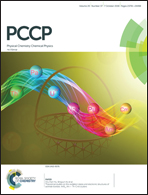Reaction mechanism of the selective reduction of CO2 to CO by a tetraaza [CoIIN4H]2+ complex in the presence of protons†
Abstract
The tetraaza [CoIIN4H]2+ complex (1) is remarkable for its ability to selectively reduce CO2 to CO with 45% Faradaic efficiency and a CO to H2 ratio of 3 : 2. We employ density functional theory (DFT) to determine the reasons behind the unusual catalytic properties of 1 and the most likely mechanism for CO2 reduction. The selectivity for CO2 over proton reduction is explained by analyzing the catalyst's affinity for the possible ligands present under typical reaction conditions: acetonitrile, water, CO2, and bicarbonate. After reduction of the catalyst by two electrons, formation of [CoIN4H]+–CO2− is strongly favored. Based on thermodynamic and kinetic data, we establish that the only likely route for producing CO from here consists of a protonation step to yield [CoIN4H]+–CO2H, followed by reaction with CO2 to form [CoIIN4H]2+–CO and bicarbonate. This conclusion corroborates the idea of a direct role of CO2 as a Lewis acid to assist in C–O bond dissociation, a conjecture put forward by other authors to explain recent experimental observations. The pathway to formic acid is predicted to be forbidden by high activation barriers, in accordance with the products that are known to be generated by 1. Calculated physical observables such as standard reduction potentials and the turnover frequency for our proposed catalytic cycle are in agreement with available experimental data reported in the literature. The mechanism also makes a prediction that may be experimentally verified: that the rate of CO formation should increase linearly with the partial pressure of CO2.
![Graphical abstract: Reaction mechanism of the selective reduction of CO2 to CO by a tetraaza [CoIIN4H]2+ complex in the presence of protons](/en/Image/Get?imageInfo.ImageType=GA&imageInfo.ImageIdentifier.ManuscriptID=C8CP01963K&imageInfo.ImageIdentifier.Year=2018)


 Please wait while we load your content...
Please wait while we load your content...